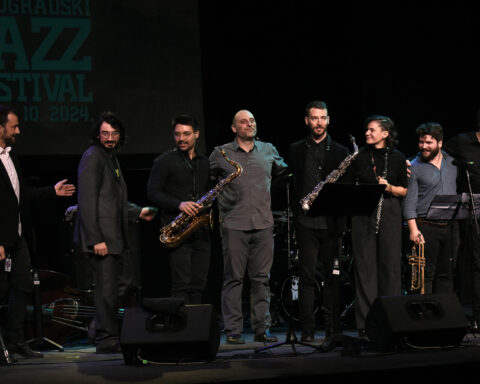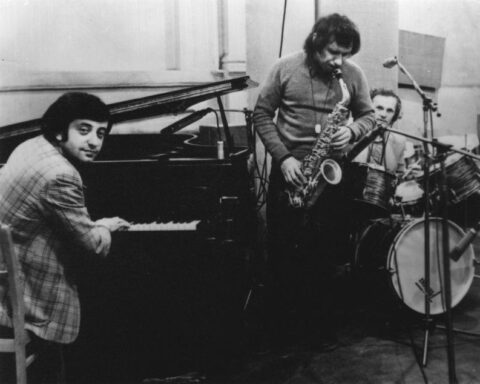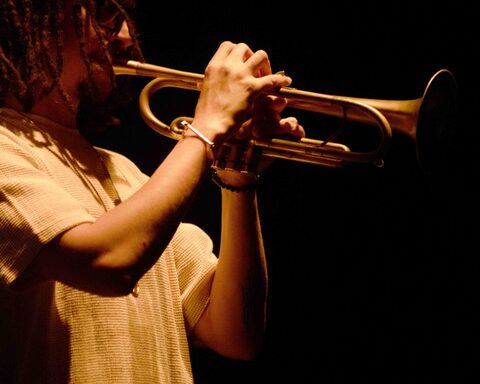None other than Sonny Rollins presides over the Performing Arts Alliance website, currently on the front-line of advocating against budget cuts for the National Endowment for the Arts.

Rollins — the 80-year-vital NEA Jazz Master, the JJA’s “Musician of the Year,” Down Beat poll winner, titular Saxophone Colossus of a deeply admiring book by JJA photographer of the year John Abbott and writer Bob Blumenthal, is hoisting his horn, white bearded, wearing a white cravate and deep blue shirt on the “About Us” page of the PAA, which is calling for action to support its number one issue: Federal Funding for the Arts.
Sonny and the PAA have something urgent to blow about, as on July 7 the U.S. House Interior Appropriations Subcommittee voted to cut NEA funding by $20 million for FY12 from a current funding level of $155 million. This reduction doubles the $9 million cut recommended by President Obama for FY12, over and above FY11’s $12.5 million budget decrease (and, disproportionately, almost double the percent cut to overall spending levels of 7% of the entire Interior bill). The PPA has launched a letter writing campaign to congresspeople serving on the committee (see the list here), urging citizens to “explain the value of the arts to public policy makers.”
Says the PPA: “It is commonplace to hear from elected officials or their staffs how wonderful the arts are. The challenge for us is turning that support into genuine understanding and commitment. Advocacy is about educating and informing elected officials, the public, and the media about the importance of the performing arts.”
This is a hard and fast stand for the member organizations of the Alliance:
- American Music Center
- Association of Performing Arts Presenters
- Chorus America
- Dance/USA
- Fractured Atlas
- League of American Orchestras
- National Alliance for Musical Theatre
- National Association of Latino Arts and Culture
- National Performance Network
- OPERA America
- Theatre Communications Group
Maintaining Federal arts funding is only where these affiliated forces start, their first priority. Other key issues, evidently in order of importance, are:
- Timely visa processing for foreign artists
- Federal support for arts education
- National policies that encourage international cultural exchange
- Favorable tax treatment of nonprofit arts organizations and charitable contributions
- National service and the arts
The PAA’s position on the proper amount of Federal dollars to go into the arts is this:
We urge Congress to support a budget of $167.5 million for the NEA in the FY 2012 Interior Appropriations bill to widen citizen access to the cultural, educational, and economic benefits of the arts, and to advance creativity and innovation in communities across the United States.
While clearly the PAA is a lobbying organization, it is not know if the Alliance actually asserts any influence upon anyone in the U.S. Congress. It’s “stories from the field” webpage leads with a posting about Congressman Norm Dicks (D-WA) being saluted in 2008 as a Champion of the Arts and Humanities by “over fifty organizations in Washington State and around the nation.” Congressman Dicks was, at the time, chair of the Interior Appropriations committee, and had led efforts to secure a $20.3 million increase for NEA in 2008 appropriations. In the current 112th Congress, Dicks remains a ranking member of the Appropriations Committee (able to sit ex officio on all subcommittees). Upon being honored in ’08, he foresaw that the budget deficit would make increases in arts funding an uphill battle, urged organizations to work for increases in overall Interior Appropriations budget allocation, and suggested they find new champions in the U.S. Senate.
Such advise seems indisputable; if arts organizations (or any other interest groups) have no champions in the Senate (or in the House of Representatives, either) they will likely be defenseless when budget axes fall. Decreases in NEA funding are sure to have a harsh consequences in the world that Sonny Rollins, for instance, plays to: arts in education programs will stall, arts support groups will close programs as they lose staffs, performing arts presenters who take it upon themselves to produce artistically challenging rather than commercially sure-fire acts will limit their offerings or turn to those same sure-fire acts that already get the exposure, and people will be blue.
Rollins and his like-minded jazz constituency know what that’s all about. Even this Performing Arts Alliance which his image is used to represent can contribute an artist’s glumness. For one thing, its scope is oddly limited. On its webpage “Performing Arts Field At A Glance,” here are the categories: Dance | Opera | Orchestra | Presenting | Theatre. How many performing arts fields does that leave out? And isn’t one of them a four letter, Congressionally certified national cultural treasure? What is music called again? Starts with a j, ends with the rare double-z?






The government has been known to spend more than $167 million on a single military airplane or highway interchange. We have plenty of both already.
The tub as well as the baby seems to be going out with the bathwater in the current frenzy of budget cutting.
A sense of proportion and propriety is needed: If we forget that civilized countries support the arts, we do so at our own peril.